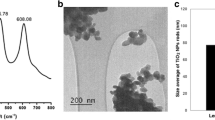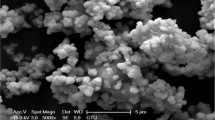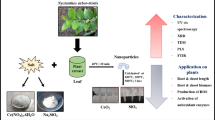Abstract
The goal of the present work was to identify the most important physiological and biological effects of titanium dioxide nanoparticles (TiO2 NPs) at a size of 83 ± 15 nm on plant parts. This was done by studying TiO2 physical and chemical properties through X-ray diffraction, scanning electron microscopy, Fourier transform infrared spectroscopy (FTIR), and Dynamic Light Scattering, and how TiO2 NPs move in plant organs and in the most important plant cells. Fenugreek (Trigonella foenum graecum L.) exposed to 100 mg L−1 of TiO2 NPs increased chlorophyll-a and -b and polyphenol contents, and decreased flavonoid level of leaves. Nano-stressed leaves and stems, therefore, displayed substantially increased catalase and ascorbate peroxidase activities. On the contrary, guaiacol peroxidase activities in the leaves and stems exposed to TiO2 NPs were significantly reduced. The result after 16 days of exposure to metal oxide was a substantial increase in the levels of nicotinamide adenine dinucleotide oxidase (NADH) in the leaves but a decrease in lipid peroxidation in the stems. The effects caused by exposure to NPs are regulated by specific isoforms of each compartment and each organ. TiO2 NPs were accumulated in the cell wall, resulting in the closure of plant cell pores that finished with the suspension of functions of the most important organelles targets such as mitochondria. We suggest that nanoparticles with size higher than 83 nm are transported via apoplastic pathway. Based on the correlations between mitochondria and cell apoptosis, accumulation of TiO2 in the cell wall causes lipid peroxidation and cell death. Metabolites changes in plants exposed to nano stressors have been determined by FTIR microspectroscopy. Environmental effect and risk of nanomaterial contamination have been studied after analyzing antioxidant enzymes. The role of oxidative stress markers in plant responses was well established.







Similar content being viewed by others
Data Availability
All data generated or analyzed during this study are included in this published article.
References
Aebi H (1984) Catalase in vitro. Methods Enzymol 105:121–126. https://doi.org/10.1016/S0076-6879(84)05016-3
Arnon D (1949) Copper enzymes in isolated chloroplasts, polyphenol oxidase in Beta vulgaris. Plant Physiol 2:1–15. https://doi.org/10.1104/pp.24.1.1
Atha DH, Wang H, Petersen EJ, Cleveland D, Holbrook RD, Jaruga P, Dizdaroglu M, Xing B, Nelson BC (2012) Copper oxide nanoparticle mediated DNA damage in terrestrial plant models. Env Sci Technol 46:1819–1827. https://doi.org/10.1021/es202660k7
Bundschuh M, Filser J, Lüderwald S, Mckee MS, Metreveli G, Schaumann GE, Schulz R, Wagner S (2018) Nanoparticles in the environment : where do we come from, where do we go to ? Environ Sci Eur 30:1–17. https://doi.org/10.1186/s12302-018-0132-6
Castiglione MR, Giorgetti L, Bellani L, Muccifora S, Bottega S, Spanò C (2016) Root responses to different types of TiO2 nanoparticles and bulk counterpart in plant model system Vicia faba L. Env Exp Bot 130:11–21. https://doi.org/10.1016/j.envexpbot.2016.05.002
Chahardoli A, Naser K, Xingmao M, Farshad Q (2020) Effects of engineered aluminum and nickel oxide nanoparticles on the growth and antioxidant defense systems of Nigella arvensis L. Sci Rep 10:1–11. https://doi.org/10.1038/s41598-020-60841-6
Chemingui H, Smiri M, Missaoui T, Hafiane A (2019) Zinc oxide nanoparticles induced oxidative stress and changes in the photosynthetic apparatus in fenugreek (Trigonella foenum graecum L.). Bull Environ Contam Toxicol 102:477–485. https://doi.org/10.1007/s00128-019-02590-5
Chen Y, Wu N, Mao H, Zhou J, Su Y, Zhang Z, Zhang H, Yuan S (2019) Different toxicities of nanoscale titanium dioxide particles in the roots and leaves of wheat seedlings. RSC Adv 9:19243–19252. https://doi.org/10.1039/c9ra02984b
Chutipaijit S, Sutjaritvorakul T (2020) Enhancements of growth and metabolites of indica rice callus ( Oryza sativa L . cv . pathumthani1 ) using TiO2 nanoparticles (NANO-TiO2). Dig J Nanomater biostructures 15:483–489 https://chalcogen.ro/483_ChutipaijiTS.pdf
Crabtree RH (2000) A new type of hydrogen bond. Science 282:2000–2001. https://doi.org/10.1126/science.282.5396.2000
Dai Y, Wang Z, Zhao J, Xu L, Xu L, Yu X, Wei Y, Xing B (2018) Interaction of CuO nanoparticles with plant cells: internalization, oxidative stress, electron transport chain disruption, and toxicogenomic responses. Environ Sci Nano 5:2269–2281. https://doi.org/10.1039/C8EN00222C
Deng X, Cheng J, Hu X, Wang L, Li D, Gao K (2017) Biological effects of TiO2 and CeO2 nanoparticles on the growth , photosynthetic activity , and cellular components of a marine diatom Phaeodactylum tricornutum. Sci Total Environ 575:87–96. https://doi.org/10.1016/j.scitotenv.2016.10.003
Faisal M, Saquib Q, Alatar AA, Khedhairy AA, Ahmed M, Ansari SM, Alwathnani HA, Dwivedi S, Musarrat J, Praveen S (2016) Cobalt oxide nanoparticles aggravate DNA damage and cell death in eggplant via mitochondrial swelling and NO signaling pathway. Biol Res 49:1–13. https://doi.org/10.1186/s40659-016-0080-9
Fielding JL, Hall JL (1978) A biolchemical and cytochemical study of peroxidase activity in roots of pisum sativum: I. a comparison of dab-peroxidase and guaiacol-peroxidase with particular emphasis on the properties of cell wall activity. J Exp Bo 29:969–981. https://doi.org/10.1016/j.desal.2010.10.052
Frohlich E (2013) Cellular targets and mechanisms in the cytotoxic action of non-biodegradable engineered nanoparticles. Curr Drug Metab 14:976–988. https://doi.org/10.1016/bs.coac.2018.10.001
Ghoto K, Simon M, Gao G, Li P (2020) Physiological and root exudation response of maize seedlings to TiO2 and SiO2 nanoparticles exposure. Bionanoscience 10:473–485. https://doi.org/10.1007/s12668-020-00724-2
Gould KS, Markham KR, Smith RH, Goris JJ (2000) Functional role of anthocyanins in the leaves of Quintinia serrata a. Cunn J Exp Bot 51:1107–1115. https://doi.org/10.1093/jexbot/51.347.1107
Haider AJ, Jameel zainab N, Al-hussaini IHM (2019) Review on : titanium dioxide applications. Energy Procedia 157:17–29. https://doi.org/10.1016/j.egypro.2018.11.159
Hernández JA, Almansa MS (2002) Short-term effects of salt stress on antioxidant systems and leaf water relations of pea leaves. Physiol Plant 115:251–257. https://doi.org/10.1034/j.1399-3054.2002.1150211.x
Hernandez-Viezcas JA, Castillo-Michel H, Peralta-Videa JR, Gardea-Torresdey JL (2015) Interactions between CeO2 nanoparticles and the desert plant Mesquite: a spectroscopy approach. Sustain Chem Eng 4:1187–1192. https://doi.org/10.1021/acssuschemeng.5b01251
Hong F, Yang F, Liu C, Gao Q, Wan Z, Gu F, Wu C, Ma Z, Zhou J, Yang P (2005a) Influences of nano-TiO2 on the chloroplast aging of spinach under light. Biol Trace Elem Res 104:249–260. https://doi.org/10.1385/BTER:104:3:249
Hong F, Zhou J, Liu C, Yang F, Wu C, Zheng L, Yang P (2005b) Effect of nano-TiO2 on photochemical reaction of chloroplasts of spinach. Biol Trace Elem Res 105:269–279. https://doi.org/10.1385/BTER:105:1-3:269
Hong SJ, Li YY, Na NR, Su TZ, Zhi L, Yongwei Z, Hui S, Wei L, Brigitte G (2017) Silver nanoparticles induced reactive oxygen species via photosynthetic energy transport imbalance in an aquatic plant. Nanotoxicology 11:157–167. https://doi.org/10.1080/17435390.2017.1278802
Hund-rinke K, Sinram T, Schlich K, Nickel C, Dickehut HP, Schmidt M, Kühnel D (2020) Attachment efficiency of Nanomaterials to algae as an important criterion for Ecotoxicity and grouping. Nanomaterials 10:1–18. https://doi.org/10.3390/nano10061021
Hussain S, Iqbal N, Brestic M, Ahmed S, Wen B, Gao Y, Liu W, Yang W (2019) Changes in morphology, chlorophyll fluorescence performance and rubisco activity of soybean in response to foliar application of ionic titanium under normal light and shade environment. Sci Total Environ 658:626–637. https://doi.org/10.1016/j.scitotenv.2018.12.182
Ishida A, Ookubo K, Ono K (1987) Formation of hydrogen peroxide by NAD ( P ) H oxidation with isolated cell wall-associated peroxidase from cultured liverwort cells. Plant Cell Physiol 28:723–726. https://doi.org/10.1093/oxfordjournals.pcp.a077349
Jaberzadeh A, Moaveni P, Tohidi Moghadam HR, Zahedi H (2013) Influence of bulk and nanoparticles titanium foliar application on some agronomic traits, seed gluten and starch contents of wheat subjected to water deficit stress. Not Bot Horti Agrobot Cluj-Napoca 41:201–207. https://doi.org/10.15835/NBHA4119093
Jahan S, Alias YB, Bakar AF, YusoffI (2018) Toxicity evaluation of ZnO and TiO2 nanomaterials in hydroponic red bean (Vigna angularis) plant: physiology, biochemistry and kinetic transport. J Environ Sci 72:1–13. https://doi.org/10.1016/j.jes.2017.12.022
Janků M, Tichá T, Luhová L, Petřivalský M (2019) Compartmentalization of reactive oxygen species and nitric oxide production in plant cells. In: Reactive oxygen, nitrogen and sulfur species in plants:production, Metabolism, Signaling and Defense Mechanisms, pp 923–945. https://doi.org/10.1002/9781119468677.ch40
Juárez-Maldonado A, Ortega-ort H, Morales-Díaz AB, González-Morales S, Morelos-Moreno Á, Cabrera-De la Fuente M, Sandoval-Rangel A, Cadenas-Pliego G, Benavides-Mendoza A (2019) Nanoparticles and nanomaterials as plant biostimulants. Int J Mol Sci Hypothesis 20:1–19. https://doi.org/10.3390/ijms20010162
Khatri K, Rathore MS (2018) Plant nanobionics and its applications for developing plants with improved photosynthetic capacity. In: Photosynthesis - From its Evolution to Future Improvements in Photosynthetic Efficiency Using Nanomaterials. https://doi.org/10.5772/intechopen.76815
Klug HP, Alexande LE (1974) X-ray diffractions procedures for polycrystalline and Anwrphous materials. 2rd edn. Wiley, New York 79:553–553. https://doi.org/10.1002/bbpc.19750790622
Lammers K, Arbuckle-keil G, Dighton J (2009) FT-IR study of the changes in carbohydrate chemistry of three New Jersey pine barrens leaf litters during simulated control burning. Soil Biol Biochem 41:340–347. https://doi.org/10.1016/j.soilbio.2008.11.005
Lead JR, Batley GE, Alvarez PJJ, Croteau M, Richard D, Mclaughlin MJ, Judy JD, Schirmer K (2018) Nanomaterials in the environment: behavior, fate, bioavailability, and effects—an updated review. Environ Toxicol Chem 37:2029–2063. https://doi.org/10.1002/etc.4147
Lei Z, Mingyu S, Xiao W, Chao L, Chunxiang Q, Liang C, Hao H, Xiaoqing L, Fashui H (2008) Antioxidant stress is promoted by nano-anatase in spinach chloroplasts under UV-B radiation. Biol Trace Elem Res 121:69–79. https://doi.org/10.1007/s12011-007-8028-0
Lichtenthaler HK, Wellburn AR (1983) Determinations of total carotenoids and chlorophylls a and b of leaf extracts in different solvents. Biochemical Society transactions. Water Sci Technol 11:591–592. https://doi.org/10.2166/wst.2006.891
Ma C, Chhikara S, Xing B, Musante C, White JC, Dhankher OP (2013) Physiological and molecular response of Arabidopsis thaliana (L.) to nanoparticle cerium and indium oxide exposure. ACS Sust Chem Eng 1:768–778. https://doi.org/10.1021/sc400098h
Middepogu A, Hou J, Gao X, Lin D (2018) Effect and mechanism of TiO2 nanoparticles on the photosynthesis of Chlorella pyrenoidosa. Ecotoxicol Environ Saf 161:497–506. https://doi.org/10.1016/j.ecoenv.2018.06.027
Missaoui T, Smiri M, Chemingui H, Alhalili Z, Hafiane A (2020) Disturbance in mineral nutrition of fenugreek grown in water polluted with nanosized titanium dioxide. Bull Environ Contam Toxicol In Press 106:327–333. https://doi.org/10.1007/s00128-020-03051-0
Missaoui T, Smiri M, Chemingui H, Jbira E, Hafiane A (2018) Regulation of mitochondrial and cytosol antioxidant systems of fenugreek (Trigonella foenum graecum L.) exposed to Nanosized titanium dioxide. Bull Environ Contam Toxicol 101:326–337. https://doi.org/10.1007/s00128-018-2414-5
Missaoui T, Smiri M, Chmingui H, Hafiane A (2017) Effects of nanosized titanium dioxide on the photosynthetic metabolism of fenugreek ( Trigonella foenum-graecum L .). C R Biol 340:499–511. https://doi.org/10.1016/j.crvi.2017.09.004
Morales MI, Rico CM, Hernandez-viezcas JA, Nunez JE, Barrios AC, Tafoya A, Flores-marges JP, Peralta-videa JR, Gardea-torresdey JL (2013) Toxicity assessment of cerium oxide nanoparticles in cilantro (Coriandrum sativum L.) plants grown in organic soil. J Agric Food Chem 61:6224–6230. https://doi.org/10.1021/jf401628v
Morteza E, Moaveni P, Farahani HA, Kiyani M (2013) Study of photosynthetic pigments changes of maize (Zea mays L.) under nano TiO2 spraying at various growth stages. Springerplus 2:1–5. https://doi.org/10.1186/2193-1801-2-247
Naghdi M, Metahni S, Ouarda Y, Brar SK (2017) Instrumental approach toward understanding nano-pollutants. Nanotechnol Environ Eng 2:1–17. https://doi.org/10.1007/s41204-017-0015-x
Nakano Y, Asada K (1981) Hydrogen peroxide is scavenged by ascorbate-specific peroxidase in spinach chloroplasts. Plant Cell Physiol 22:867–880. https://doi.org/10.1093/oxfordjournals.pcp.a076232
Naumann D, Helm D, Labischinski H, Giesbrecht P (1991) The characterisation of microorganisms by Fourier-transform infrared spectroscopy (FT-IR). In: Nelson WH (ed) Modern techniques for rapid microbiological analysis. VCH Publ, New York, pp 43–96. https://doi.org/10.1371/journal.pone.0097881
Nile SH, Baskar V, Selvaraj D, Nile A (2020) Nanotechnologies in food science: applications, recent trends, and future perspectives. Nano-Micro Lett 12:1–34. https://doi.org/10.1007/s40820-020-0383-9
Niltharach A, Kityakarn S, Worayingyong A, Thienprasert JT, Klysubune W, Songsiriritthigulef P, Limpijumnong S (2012) Structural characterizations of sol – gel synthesized TiO2 and Ce/TiO2 nanostructures. Phys B 407:2915–2918. https://doi.org/10.1016/j.physb.2011.08.108
Ogunkunle CO, Adegboye EF, Okoro HK, Vishwakarma V, Alagarsamy K, Fatoba PO (2020) Effect of nanosized anatase TiO2 on germination, stress defense enzymes, and fruit nutritional quality of Abelmoschus esculentus ( L .) Moench ( okra ). Arab J Geosc 13:1–13. https://doi.org/10.1007/s12517-020-5121-6
Piro G, Leucci MR, Waldron K, Dalessandro G (2003) Exposure to water stress causes changes in the biosynthesis of cell wall polysaccharides in roots of wheat cultivars varying in drought tolerance. Plant Sci 165:559–569. https://doi.org/10.1016/S0168-9452(03)00215-2
Planchuelo G, Von Der Lippe M, Kowarik I (2019) Landscape and urban planning untangling the role of urban ecosystems as habitats for endangered plant species. Landsc Urban Plan 189:320–334. https://doi.org/10.1016/j.landurbplan.2019.05.007
Rico C, Hong J, Morales MI, Zhao L, Barrios AC, Zhang Y, Peralta-videa JR, Gardea-torresdey JL (2013) Effect of cerium oxide nanoparticles on rice : a study involving the antioxidant defense system and in vivo fluorescence imaging. Environ Sci Technol 47:5635–5642. https://doi.org/10.1021/es401032m
Satalkar P, Elger BS, Shaw DM (2016) Defining nano, nanotechnology and nanomedicine: why should it matter? Sci Eng Ethics 22:1255–1276. https://doi.org/10.1007/s11948-015-9705-6
Scott M (2014) Sunscreen compositions for application to plants. United States patent US 8,986,741B2.https://patentimages.storage.googleapis.com/b7/30/87/0b441978552acf/US8986741.pdf
Shabbir A, Khan MMA, Ahmad B, Sadiq Y, Jaleel H, Uddin M (2019) Efficacy of TiO2 nanoparticles in enhancing the photosynthesis, essential oil and khusimol biosynthesis in Vetiveria zizanioides L . Nash. Photosynthetica 57:599–606. https://doi.org/10.32615/ps.2019.071
Shang Y, Wu F, Wei S, Guo W, Chen J, Huang W, Hu M, Wang Y (2020) Specific dynamic action of mussels exposed to TiO2 nanoparticles and seawater acidification. Chemosphere 241:125104. https://doi.org/10.1016/j.chemosphere.2019.125104
Siddiqui MH, Al-Whaibi MH, Firoz M, Al-Khaishany MY (2015) Nanotechnology and plant sciences. Springer International Publishing, Switzerland, p 305. https://doi.org/10.1007/978-3-319-14502-0
Silva S, Craveiro SC, Oliveira H, Calado AJ, Ricardo JB, Silva AMS, Santos C (2017) Wheat chronic exposure to TiO2-nanoparticles: Cyto- and genotoxic approach. Plant Physiol Biochem 121:89–98. https://doi.org/10.1016/j.plaphy.2017.10.013
Silva S, Miguel J, De Oliveira PF, Celeste M, Silva AMS (2019) Antioxidant mechanisms to counteract TiO2 -nanoparticles toxicity in wheat leaves and roots are organ dependent. J Hazard Mater 380:1–10. https://doi.org/10.1016/j.jhazmat.2019.120889
Singleton VL, Rossi JAJ (1965) Colorimetry of total phenolics with phosphomolybdic- phosphotungstic acid reagents. Am J Enol Vitic 16:144–158. https://doi.org/10.1017/CBO9781107415324.004
Smiri M, Chaoui A, El Ferjani E (2009) Respiratory metabolism in the embryonic axis of germinating pea seed exposed to cadmium. J Plant Physiol 166:259–269. https://doi.org/10.1016/j.jplph.2008.05.006
Song C, Huang M, White JC, Zhang X, Wang W, Kyei Sarpong C, Hussain Z, Zhang H, Zhao L, Wang Y (2020) Metabolic profile and physiological response of cucumber foliar exposed to engineered MOS2 and TiO2 nanoparticles. NanoImpact 20:1–10. https://doi.org/10.1016/j.impact.2020.100271
Tighe-neira R, Reyes-díaz M, Nunes-nesi A, Recio G, Carmona E, Corgne A, Rengel Z, Inostroza-blancheteau C (2020) Titanium dioxide nanoparticles provoke transient increase in photosynthetic performance and differential response in antioxidant system in Raphanus. Sci Hortic (Amsterdam) 269:1–10. https://doi.org/10.1016/j.scienta.2020.109418
Tripathi DK, Singh S, Singh S, Pandey R, Pratap V, Sharma NC, Mohan S, Kishore N, Kumar D (2017) Plant physiology and biochemistry an overview on manufactured nanoparticles in plants : uptake, translocation, accumulation and phytotoxicity. Plant Physiol Biochem 110:2–12. https://doi.org/10.1016/j.plaphy.2016.07.030
Verma G, Srivastava D, Tiwari P, Chakrabarty D (2019) ROS modulation in crop plants under drought stress. In: reactive oxygen, nitrogen and sulfur species in plants: production, metabolism, signaling and defense mechanisms. John Wiley & Sons Ltd, West Sussex, UK, pp 311–336. https://doi.org/10.1002/9781119468677.ch13
Vittori Antisari L, Carbone S, Gatti A, Vianello G, Nannipieri P (2014) Uptake and translocation of metals and nutrients in tomato grown in soil polluted with metal oxide (CeO2, Fe3O4, SnO2, TiO2) or metallic (Ag, co, Ni) engineered nanoparticles. Environ Sci Pollut Res 22:1841–1853. https://doi.org/10.1007/s11356-014-3509-0
Wang L, Sun J, Lin L, Funa Y, Aleniusc H, Lindseyd K, Chen C (2020) Silver nanoparticles regulate Arabidopsis root growth by concentration-dependent modification of reactive oxygen species accumulation and cell division. Ecotoxicol Environ Saf 190:1–9. https://doi.org/10.1016/j.ecoenv.2019.110072
Wu B, Zhu L, Le XC (2017) Metabolomics analysis of TiO2 nanoparticles induced toxicological effects on rice (Oryza sativa L.). Environ Pollut 230:302–310. https://doi.org/10.1016/j.envpol.2017.06.062
Xia B, Chen B, Sun X, Qu K, Ma F, Du M (2015) Interaction of TiO2 nanoparticles with the marine microalga Nitzschia closterium: growth inhibition, oxidative stress and internalization. Sci Total Environ 508:525–533. https://doi.org/10.1016/j.scitotenv.2014.11.066
Yang F, Hong F, You W, Liu C, Gao F, Wu C, Yang P (2006) Influences of nano-anatase TiO2 on the nitrogen metabolism of growing spinach. Biol Trace Elem Res 110:179–190. https://doi.org/10.1385/BTER:110:2:179
Zayneb C, Bassem K, Zeineb K, Grubb CD, Noureddine D, Hafedh M (2015) Physiological responses of fenugreek seedlings and plants treated with cadmium. Environ Sci Pollut Res 22:10679–10689. https://doi.org/10.1007/s11356-015-4270-8
Zhishen J, Mengcheng TJW, Jianming W (1999) The determination of flavonoid contents in mulberry and their scavenging effects on superoxide radicals. Food Chem 64(4):555–559. https://doi.org/10.1016/S0308-8146(98)00102-2
Zuverza-mena N, Armendariz R, Peralta-videa JR (2016) Effects of silver nanoparticles on radish sprouts : root growth reduction and modifications in the nutritional value. Front Plant Sci 7:1–11. https://doi.org/10.3389/fpls.2016.00090
Acknowledgments
We thank Dr. Tawhida Akhter, Assistant Professor in the Department of English Language, Shaqra University Saudi Arabia, for check of language. We are thankful to the anonymous reviewers for helpful comments on the manuscript.
Funding
No funding was received.
Author information
Authors and Affiliations
Contributions
All authors contributed to the study conception and design. Material preparation, data collection and analysis were performed by [Takwa Missaoui], [Moez Smiri], [Hajer Chemingui] and [Amor Hafiane]. The first draft of the manuscript was written by [Takwa Missaoui] and all authors commented on previous versions of the manuscript. All authors read and approved the final manuscript.
Conceptualization: [Moez Smiri]; Methodology: [Takwa Missaoui], [Hajer Chemingui]; Formal analysis and investigation: [Takwa Missaoui], [Moez Smiri]; Writing - original draft preparation: [Takwa Missaoui], [Moez Smiri]; Writing - review and editing: [Amor Hafiane]; Funding acquisition: [Takwa Missaoui]; Resources: [Amor Hafiane]; Supervision: [Moez Smiri].
Corresponding author
Ethics declarations
Disclosure of Interest
The authors declare that they have no conflict of interest.
Additional information
Publisher’s Note
Springer Nature remains neutral with regard to jurisdictional claims in published maps and institutional affiliations.
Rights and permissions
About this article
Cite this article
Missaoui, T., Smiri, M., Chemingui, H. et al. Effect of Nanosized TiO2 on Redox Properties in Fenugreek (Trigonella foenum graecum L.) during Germination. Environ. Process. 8, 843–867 (2021). https://doi.org/10.1007/s40710-020-00493-w
Received:
Accepted:
Published:
Issue Date:
DOI: https://doi.org/10.1007/s40710-020-00493-w




